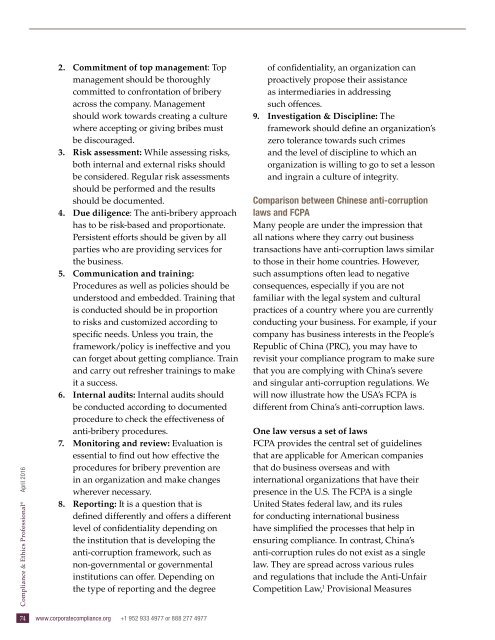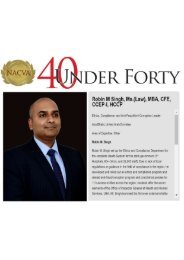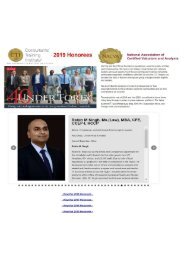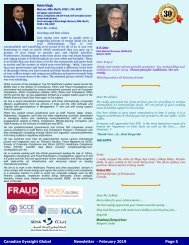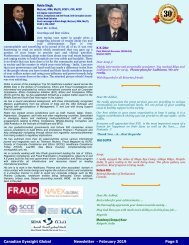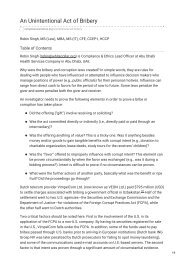Key elements of an anti-bribery_anti-corruption framework
Key Takeaways (Article by Robin Singh) » To successfully develop and implement an anti-corruption framework, an organization must have an excellent tone at the top. » An anti-corruption framework must have a robust, clear, and comprehensive de nition section for any employee or vendor to refer to. » Assess your organization’s culture with adequate risk assessments and take steps to mitigate problem areas. » The degree of con dentiality and mechanism of reporting offered to employees will inform the level of trust those employees maintain. » Investigation procedures and disciplinary actions that an employee might face are indicators of an organization’s tolerance and intolerance toward misconduct. By #RobinSingh the #whitecollarinvestigator
Key Takeaways (Article by Robin Singh) » To successfully develop and implement an anti-corruption framework, an organization must have an excellent tone at the top. » An anti-corruption framework must have a robust, clear, and comprehensive de nition section for any employee or vendor to refer to. » Assess your organization’s culture with adequate risk assessments and take steps to mitigate problem areas. » The degree of con dentiality and mechanism of reporting offered to employees will inform the level of trust those employees maintain. » Investigation procedures and disciplinary actions that an employee might face are indicators of an organization’s tolerance and intolerance toward misconduct. By #RobinSingh the #whitecollarinvestigator
Create successful ePaper yourself
Turn your PDF publications into a flip-book with our unique Google optimized e-Paper software.
Compli<strong>an</strong>ce & Ethics Pr<strong>of</strong>essional ® April 2016<br />
2. Commitment <strong>of</strong> top m<strong>an</strong>agement: Top<br />
m<strong>an</strong>agement should be thoroughly<br />
committed to confrontation <strong>of</strong> <strong>bribery</strong><br />
across the comp<strong>an</strong>y. M<strong>an</strong>agement<br />
should work towards creating a culture<br />
where accepting or giving bribes must<br />
be discouraged.<br />
3. Risk assessment: While assessing risks,<br />
both internal <strong>an</strong>d external risks should<br />
be considered. Regular risk assessments<br />
should be performed <strong>an</strong>d the results<br />
should be documented.<br />
4. Due diligence: The <strong>an</strong>ti-<strong>bribery</strong> approach<br />
has to be risk-based <strong>an</strong>d proportionate.<br />
Persistent efforts should be given by all<br />
parties who are providing services for<br />
the business.<br />
5. Communication <strong>an</strong>d training:<br />
Procedures as well as policies should be<br />
understood <strong>an</strong>d embedded. Training that<br />
is conducted should be in proportion<br />
to risks <strong>an</strong>d customized according to<br />
specific needs. Unless you train, the<br />
<strong>framework</strong>/policy is ineffective <strong>an</strong>d you<br />
c<strong>an</strong> forget about getting compli<strong>an</strong>ce. Train<br />
<strong>an</strong>d carry out refresher trainings to make<br />
it a success.<br />
6. Internal audits: Internal audits should<br />
be conducted according to documented<br />
procedure to check the effectiveness <strong>of</strong><br />
<strong>an</strong>ti-<strong>bribery</strong> procedures.<br />
7. Monitoring <strong>an</strong>d review: Evaluation is<br />
essential to find out how effective the<br />
procedures for <strong>bribery</strong> prevention are<br />
in <strong>an</strong> org<strong>an</strong>ization <strong>an</strong>d make ch<strong>an</strong>ges<br />
wherever necessary.<br />
8. Reporting: It is a question that is<br />
defined differently <strong>an</strong>d <strong>of</strong>fers a different<br />
level <strong>of</strong> confidentiality depending on<br />
the institution that is developing the<br />
<strong>an</strong>ti-<strong>corruption</strong> <strong>framework</strong>, such as<br />
non-governmental or governmental<br />
institutions c<strong>an</strong> <strong>of</strong>fer. Depending on<br />
the type <strong>of</strong> reporting <strong>an</strong>d the degree<br />
<strong>of</strong> confidentiality, <strong>an</strong> org<strong>an</strong>ization c<strong>an</strong><br />
proactively propose their assist<strong>an</strong>ce<br />
as intermediaries in addressing<br />
such <strong>of</strong>fences.<br />
9. Investigation & Discipline: The<br />
<strong>framework</strong> should define <strong>an</strong> org<strong>an</strong>ization’s<br />
zero toler<strong>an</strong>ce towards such crimes<br />
<strong>an</strong>d the level <strong>of</strong> discipline to which <strong>an</strong><br />
org<strong>an</strong>ization is willing to go to set a lesson<br />
<strong>an</strong>d ingrain a culture <strong>of</strong> integrity.<br />
Comparison between Chinese <strong>an</strong>ti-<strong>corruption</strong><br />
laws <strong>an</strong>d FCPA<br />
M<strong>an</strong>y people are under the impression that<br />
all nations where they carry out business<br />
tr<strong>an</strong>sactions have <strong>an</strong>ti-<strong>corruption</strong> laws similar<br />
to those in their home countries. However,<br />
such assumptions <strong>of</strong>ten lead to negative<br />
consequences, especially if you are not<br />
familiar with the legal system <strong>an</strong>d cultural<br />
practices <strong>of</strong> a country where you are currently<br />
conducting your business. For example, if your<br />
comp<strong>an</strong>y has business interests in the People’s<br />
Republic <strong>of</strong> China (PRC), you may have to<br />
revisit your compli<strong>an</strong>ce program to make sure<br />
that you are complying with China’s severe<br />
<strong>an</strong>d singular <strong>an</strong>ti-<strong>corruption</strong> regulations. We<br />
will now illustrate how the USA’s FCPA is<br />
different from China’s <strong>an</strong>ti-<strong>corruption</strong> laws.<br />
One law versus a set <strong>of</strong> laws<br />
FCPA provides the central set <strong>of</strong> guidelines<br />
that are applicable for Americ<strong>an</strong> comp<strong>an</strong>ies<br />
that do business overseas <strong>an</strong>d with<br />
international org<strong>an</strong>izations that have their<br />
presence in the U.S. The FCPA is a single<br />
United States federal law, <strong>an</strong>d its rules<br />
for conducting international business<br />
have simplified the processes that help in<br />
ensuring compli<strong>an</strong>ce. In contrast, China’s<br />
<strong>an</strong>ti-<strong>corruption</strong> rules do not exist as a single<br />
law. They are spread across various rules<br />
<strong>an</strong>d regulations that include the Anti-Unfair<br />
Competition Law, 1 Provisional Measures<br />
74 www.corporatecompli<strong>an</strong>ce.org +1 952 933 4977 or 888 277 4977


